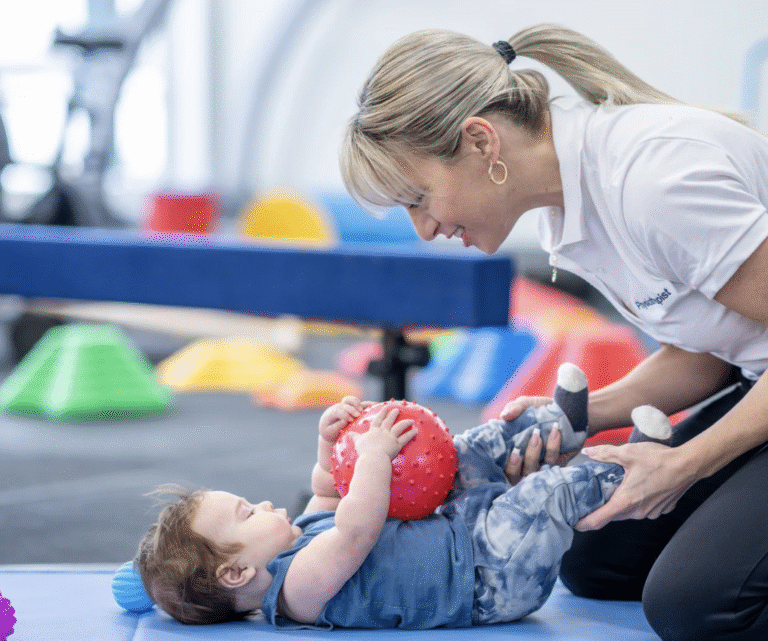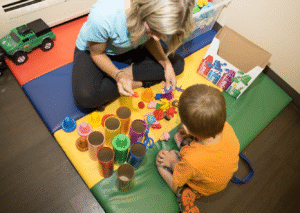Reflex integration therapy is an approach used by occupational and physical therapists to help organize the nervous system by addressing retained primitive reflexes — automatic movement patterns that develop in infancy and lay the foundation for higher-level motor, sensory, and cognitive skills.
These reflexes (like the Moro, TLR, ATNR, and STNR) should typically integrate — or “disappear” — as a child’s brain matures. However, in many children with Autism Spectrum Disorder (ASD), these reflexes remain active longer than normal, affecting posture, coordination, attention, and even emotional regulation.
When these reflexes are retained, a child’s body and brain can feel “stuck” in early movement patterns, which may interfere with their ability to sit still, focus, communicate, or interact comfortably with others. Reflex integration therapy helps “retrain” the brain and body to work together, building a stronger foundation for learning and development.
How Reflex Integration Relates to Autism
Children with autism often present with challenges in motor coordination, sensory processing, and emotional regulation, all of which are influenced by the neurological pathways connected to primitive reflexes. If these reflexes remain unintegrated, they can contribute to:
- Difficulty sitting still or maintaining posture
- Poor balance and coordination
- Trouble with eye tracking or visual-motor control
- Limited body awareness or motor planning
- Difficulty following directions or sustaining attention
- Emotional outbursts or sensory overload
For example, the Tonic Labyrinthine Reflex (TLR), which helps infants develop balance and posture, can cause difficulties in sitting upright, handwriting, or transitioning between
movements if it remains active. Likewise, the Asymmetrical Tonic Neck Reflex (ATNR), important for early hand-eye coordination, may affect a child’s ability to cross midline or use both hands together effectively.
How Reflex Integration Therapy Works
Therapists trained in reflex integration use specific repetitive movement patterns, gentle stretching, and sensory-motor activities to stimulate the brain and help “complete” these early developmental stages.
These movements mimic the natural motions babies make as their nervous systems develop — such as rolling, crawling, or reaching — and can help form new neural connections that promote motor control, attention, and calmness.
Therapy sessions are individualized and may include:
- Core strengthening to improve posture and stability
- Cross-body movements to enhance coordination and bilateral integration
- Deep pressure and sensory input for calming and organization
- Balance and vestibular exercises to improve spatial awareness
- Functional tasks that link reflex patterns to real-life activities like handwriting or self-care
Over time, as reflexes integrate, children often show improvements in focus, coordination, emotional control, and learning readiness.
The Benefits of Reflex Integration for Children with Autism
Reflex integration therapy offers numerous benefits that go beyond movement alone. It supports whole-brain organization, which impacts how a child processes, responds, and interacts with their environment.
Key benefits include:
- Improved attention and concentration
- Enhanced body awareness and coordination
- Better handwriting and fine motor skills
- Reduced sensory sensitivities and meltdowns
- Greater independence in self-care tasks
- Increased calmness and ability to regulate emotions
Many parents and teachers notice that children are more engaged in learning, less overwhelmed by sensory input, and more confident after participating in reflex integration-based therapy.
How Crawl Walk Jump Run Therapy Clinic Helps
At Crawl Walk Jump Run Therapy Clinic, our occupational and physical therapists use a neurodevelopmental approach that incorporates reflex integration into individualized therapy plans.
We focus on identifying which reflexes remain active and how they impact each child’s motor, sensory, and emotional development.
By combining reflex integration, sensory processing, and functional skill development, we help children with autism reach their fullest potential — improving not only physical abilities but also confidence, participation, and quality of life.
Our therapists also provide home exercise programs to reinforce reflex integration techniques and help families carry over progress into daily routines.
Empower Your Child’s Growth with Reflex Integration Therapy
If your child struggles with coordination, attention, or sensory challenges associated with autism, reflex integration therapy may be the missing piece to help unlock their potential. Contact Crawl Walk Jump Run Therapy Clinic today to schedule a free consultation with one of our expert therapists and learn how we can support your child’s development through evidence-based neurotherapy approaches.




